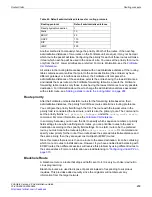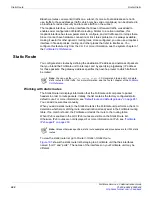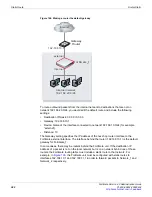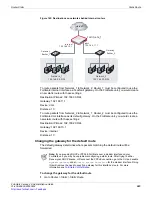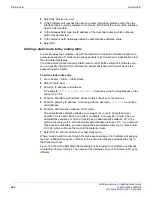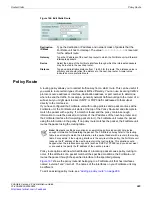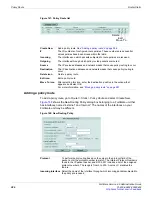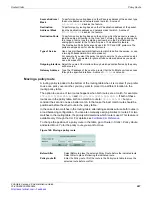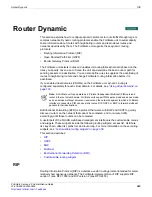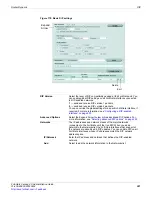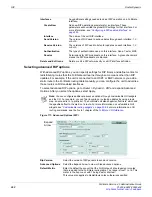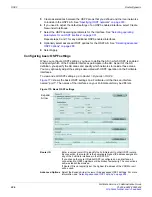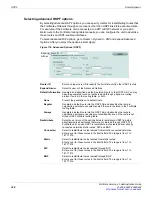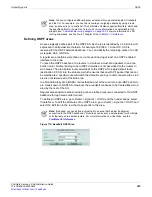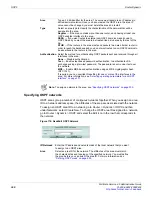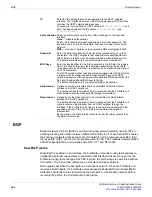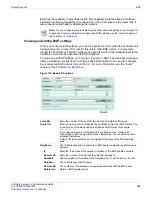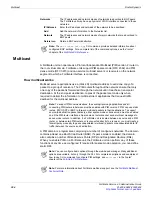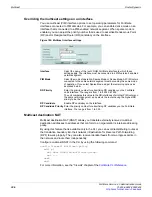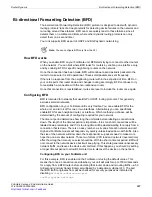
Router Dynamic
RIP
FortiGate Version 4.0 Administration Guide
01-400-89802-20090424
293
•
Configuring a RIP-enabled interface
You can use RIP interface options to override the global RIP settings that apply to all
FortiGate unit interfaces connected to RIP-enabled networks. For example, if you want to
suppress RIP advertising on an interface that is connected to a subnet of a RIP-enabled
network, you can set the interface to operate passively. Passive interfaces listen for RIP
updates but do not respond to RIP requests.
If RIP version 2 is enabled on the interface, you can optionally choose password
authentication to ensure that the FortiGate unit authenticates a neighboring router before
accepting updates from that router. The unit and the neighboring router must both be
configured with the same password. Authentication guarantees the authenticity of the
update packet, not the confidentiality of the routing information in the packet.
To set specific RIP operating parameters for a RIP-enabled interface, go to
Router >
Dynamic > RIP
and select Create New
.
Default-information-
originate
Select to generate and advertise a default route into the FortiGate unit’s RIP-
enabled networks. The generated route may be based on routes learned
through a dynamic routing protocol, routes in the routing table, or both.
RIP Timers
Enter new values to override the default RIP timer settings. The default
settings are effective in most configurations — if you change these settings,
ensure that the new settings are compatible with local routers and access
servers.
If the Update timer is smaller than Timeout or Garbage timers, you will get an
error.
Update
Enter the amount of time (in seconds) that the FortiGate unit will wait
between sending RIP updates.
Timeout
Enter the maximum amount of time (in seconds) that a route is considered
reachable while no updates are received for the route. This is the maximum
time the FortiGate unit will keep a reachable route in the routing table while
no updates for that route are received. If the FortiGate unit receives an
update for the route before the timeout period expires, the timer is restarted.
The Timeout period should be at least three times longer than the Update
period.
Garbage
Enter the amount of time (in seconds) that the FortiGate unit will advertise a
route as being unreachable before deleting the route from the routing table.
The value determines how long an unreachable route is kept in the routing
table.
Redistribute
Select one or more of the options to redistribute RIP updates about routes
that were not learned through RIP. The FortiGate unit can use RIP to
redistribute routes learned from directly connected networks, static routes,
OSPF, and BGP.
Connected
Select to redistribute routes learned from directly connected networks. To
specify a hop count for those routes, select Metric, and enter the hop count
in the Metric field. The valid hop count range is from 1 to 16.
Static
Select to redistribute routes learned from static routes. To specify a hop
count for those routes, select Metric, and enter the hop count in the Metric
field. The range is from 1 to 16.
OSPF
Select to redistribute routes learned through OSPF. To specify a hop count
for those routes, select Metric, and enter the hop count in the Metric field.
The range is from 1 to 16.
BGP
Select to redistribute routes learned through BGP. To specify a hop count for
those routes, select Metric, and enter the hop count in the Metric field. The
range is from 1 to 16.
Note:
Additional options such as split-horizon and key-chains can be configured per
interface through the CLI. For more information, see the “router” chapter of the
or the Fortinet Knowledge Center.
Summary of Contents for Gate 60D
Page 705: ...www fortinet com...
Page 706: ...www fortinet com...

